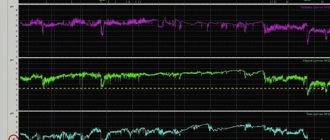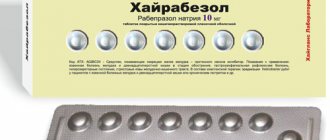Description
Capsule-shaped tablets of white or almost white color with a score.
Pharmacotherapeutic group:
antibiotic - semisynthetic penicillin
ATX code:
J01CA04
Pharmacological properties
Pharmacodynamics
Amoxicillin is an aminobenzyl penicillin, a semisynthetic broad-spectrum antibiotic that has a bactericidal effect due to inhibition of bacterial cell wall synthesis. Minimum inhibitory concentration (MIC) thresholds for different sensitive microorganisms vary. The prevalence of resistant strains varies geographically and over time, so it is advisable to rely on local resistance information, especially when treating severe infections.
Pharmacokinetics
Suction
Absorption is fast, high (93%), food intake does not affect absorption, and is not destroyed in the acidic environment of the stomach. When taken orally at a dose of 250 mg and 500 mg, the maximum concentration in blood plasma is 5 mcg/ml and 10 mcg/ml, respectively. The time to reach maximum concentration after oral administration is 1-2 hours.
Distribution
It has a large volume of distribution - high concentrations are found in blood plasma, bronchial secretions (in purulent bronchial secretions the distribution is weak), liver, lymph nodes, uterus, ovaries, paranasal sinuses, pleural and peritoneal fluid, saliva and tear fluid, urine, contents of skin blisters , lung tissue, intestinal mucosa, middle ear fluid and paranasal sinuses, bones, adipose tissue, gall bladder (the concentration in bile is 10 times higher than the concentration in blood plasma - with normal patency of the bile ducts), fetal tissues. When the dose is doubled, the concentration also doubles. In the amniotic fluid and umbilical cord vessels, the concentration of amoxicillin is about 50% of the concentration in the blood plasma of a pregnant woman. It penetrates poorly through the blood-brain barrier; with inflammation of the meninges (meningitis), the concentration in the cerebrospinal fluid increases to 20% of the concentration in the blood plasma. Bonding with blood plasma proteins is 15-25%.
Metabolism
Partially (10-20%) is metabolized to form inactive metabolites.
Removal
The half-life (T1/2) is 1-1.5 hours. It is excreted 50-70% unchanged by the kidneys through tubular excretion (80%) and glomerular filtration (20%), and 10-20% by the liver. A small amount is excreted in breast milk. If renal function is impaired (creatinine clearance [CC] ≤ 15 ml/min), T1/2 is extended to 8.5 hours.
Amoxicillin is removed by hemodialysis.
Special patient groups
Age
T1/2 of amoxicillin in children aged 3 months to 2 years is similar to T1/2 in older children and adults.
Since in elderly patients the likelihood of decreased renal function increases, dose selection is carried out with caution, and monitoring of renal function is also necessary.
Floor
When administered orally to healthy men and women, the gender of the patients does not have a significant effect on the pharmacokinetics of amoxicillin.
Kidney failure
The total serum clearance of amoxicillin increases in proportion to the decrease in renal function. If renal function is impaired (creatinine clearance < 15 ml/min), T1/2 lengthens and can reach 8.5 hours in anuria.
Liver failure
In patients with impaired liver function, dose selection should be carried out with caution, and regular monitoring of liver function is necessary.
Amoxicillin
Amoxicillin
(Latin
amoxycillinum
, English
amoxicillin
) is a broad-spectrum antibacterial, bactericidal, acid-resistant agent from the group of semi-synthetic penicillins.
Amoxicillin is a chemical substance
Chemical compound: [2S-[2alpha,5alpha,6beta(S*)]]-6-[[Amino-(4-hydroxyphenyl)acetyl]amino]-3,3-dimethyl-7-oxo-4-thia-1 -azabicyclo[3.2.0]heptane-2-carboxylic acid (and as trihydrate or sodium salt). Empirical formula: C16H19N3O5S.
Amoxicillin is the international nonproprietary name of the drug
Amoxicillin is the international nonproprietary name (INN) of the drug. According to the pharmacological index, amoxicillin belongs to the group “Penicillins”, according to ATC - to the group “J01C Beta-lactam antibiotics - penicillins” and has the code “J01CA04 Amoxicillin”. In addition, amoxicillin is present in a number of combination drug codes. In the group “A02BD Combinations of drugs for eradication of Helicobacter pylori
”:
- A02BD01 Omeprazole, amoxicillin and metronidazole
- A02BD03 Lansoprazole, amoxicillin and metronidazole
- A02BD04 Pantoprazole, amoxicillin and clarithromycin
- A02BD05 Omeprazole, amoxicillin and clarithromycin
- A02BD06 Esomeprazole, amoxicillin and clarithromycin
- A02BD07 Lansoprazole, amoxicillin and clarithromycin
- A02BD10 Lansoprazole, amoxicillin and levofloxacin
- A02BD11 Pantoprazole, amoxicillin, clarithromycin and metronidazole
- A02BD12 Rabeprazole, amoxicillin and clarithromycin
- A02BD13 Rabeprazole, amoxicillin and metronidazole
- A02BD14 Vonoprazan, amoxicillin and clarithromycin
- A02BD15 Vonoprazan, amoxicillin and metronidazole
In the group "J01C Beta-lactam antibiotics - penicillins":
- J01CR02 Amoxicillin in combination with beta-lactamase inhibitors
“Amoxicillin” is also a trade name for a number of drugs.
Amoxicillin is an antibiotic
Amoxicillin is active against many microbes, including:
- aerobic gram-negative bacteria: Helicobacter pylori, Neisseria gonorrhoeae, Neisseria meningitidis, Escherichia coli, Proteus mirabilis, Haemophilus influenzae
,
Salmonella spp., Shigella spp., Klebsiella spp. - aerobic gram-positive bacteria: Staphylococcus spp.
(except penicillinase-producing strains),
Streptococcus spp
.
Serratia spp., Enterobacter spp., Morganella morganii, Pseudomonas spp.
are not sensitive to amoxicillin ,
Rickettsiaceae
, indole-positive
Proteus
(
Proteus vulgaris, Proteus rettgeri
), as well as mycoplasmas and viruses.
Indications for use of amoxicillin
Bacterial infections caused by sensitive microflora:
- sinusitis, tonsillitis, otitis media
- bronchitis, pneumonia
- pyelonephritis, pyelitis, cystitis, cholangitis, cholecystitis, urethritis, gonorrhea, cervicitis
- infections of the skin and soft tissues: erysipelas, impetigo, secondary infected dermatoses
- dysentery, salmonellosis, salmonella carriage, endocarditis, meningitis, sepsis
Peptic ulcer of the stomach, duodenum, atrophic gastritis, MALToma and gastric resection after gastric cancer when Helicobacter pylori
strictly as part of eradication regimens in combination with other drugs.
Method of administration of amoxicillin and dose
They are installed individually, taking into account the severity of the infection.
- Adults and children over 10 years of age are usually prescribed 500 mg 3 times a day. In severe cases of infection, the dose can be increased to 1 g 3 times a day.
- For children under 10 years of age, it is advisable to prescribe the drug in the form of a suspension.
- Children under 2 years old: 1/4 teaspoon of suspension 3 times a day (or at the rate of 20 mg/kg in 3 divided doses)
- Children from 2 to 5 years old: 1/2 teaspoon of suspension 3 times a day.
- Children 5–10 years old are usually prescribed 1 teaspoon of suspension or 1 capsule of 250 mg 3 times a day.
The course of treatment with amoxicillin is 5–14 days. The suspension is prepared by adding boiled water at room temperature to the dry substance to the 100 ml mark and then shaking. For acute uncomplicated gonorrhea, a single dose of 3 g is prescribed. Children 5–10 years old are usually prescribed 250 mg 3 times a day; from 2 to 5 years - 125 mg 3 times a day; for children under 2 years of age, the daily dose is 20 mg/kg in 3 divided doses.
Amoxicillin in Helicobacter pylori eradication regimens
Amoxicillin is classified by WHO as a drug active against Helicobacter pylori
(Podgorbunskikh E.I., Maev I.V., Isakov V.A.).
According to the “Standards for diagnosis and treatment of acid-dependent and Helicobacter pylori-associated diseases (Fourth Moscow Agreement),” amoxicillin can be included in Helicobacter pylori
.
Monotherapy of Helicobacter pylori
with amoxicillin is not allowed.
This standard recommends the following regimens with amoxicillin for first-line anti-Helicobacter therapy
, and the choice of a specific option depends on the patient’s individual intolerance to certain drugs, as well as the sensitivity of
Helicobacter pylori
to drugs:
Option 1.
One of the standard dosage proton pump inhibitors (omeprazole 20 mg, lansoprazole 30 mg, pantoprazole 40 mg, esomeprazole 20 mg, rabeprazole 20 mg twice daily) and amoxicillin (500 mg 4 times daily or 1000 mg twice daily) in combination with clarithromycin (500 mg 2 times a day), or josamycin (1000 mg 2 times a day), or nifuratel (400 mg 2 times a day) for 10-14 days.
Option 2.
Drugs used in the first option (one of the PPIs in a standard dosage, amoxicillin in combination with clarithromycin, or josamycin, or nifuratel) with the addition of a fourth component - bismuth tripotassium dicitrate 120 mg 4 times a day or 240 mg 2 times a day for 10– 14 days.
Option 3 (in the presence of atrophy of the gastric mucosa with achlorhydria, confirmed by pH-metry).
Amoxicillin (500 mg 4 times a day or 1000 mg 2 times a day) in combination with clarithromycin (500 mg 2 times a day) or josamycin (1000 mg 2 times a day), or nifuratel (400 mg 2 times a day), and bismuth tripotassium dicitrate (120 mg 4 times a day or 240 mg 2 times a day) for 10-14 days.
Option 4 (recommended only for elderly patients in situations in which full-fledged anti-Helicobacter therapy is impossible)
. One standard-dose PPI in combination with amoxicillin (500 mg 4 times daily or 1000 mg twice daily) and tripotassium bismuth dicitrate (120 mg 4 times daily or 240 mg twice daily) for 14 days.
Second line of anti-Helicobacter therapy.
It is carried out in the absence of eradication of Helicobacter pylori after treating patients with one of the first-line treatment options.
One of the standard dosage PPIs, amoxicillin (500 mg 4 times a day or 1000 mg 2 times a day) in combination with a nitrofuran drug: nifuratel (400 mg 2 times a day) or furazolidone (100 mg 4 times a day) and bismuth Tripotassium dicitrate (120 mg 4 times a day or 240 mg 2 times a day) for 10-14 days.
or
One standard-dose PPI, amoxicillin (500 mg 4 times daily or 1000 mg twice daily), rifaximin (400 mg twice daily), tripotassium bismuth dicitrate (120 mg 4 times daily) for 14 days .
“What guides us when preserving penicillins (amoxicillin) in the treatment of H. pylori
as part of 1st line eradication therapy? First of all, amoxicillin is characterized by a very low level of resistance, practically its absence. Amoxicillin is well absorbed from the gastrointestinal tract, does not irritate the gastric mucosa and rarely causes diarrhea. Has a wide spectrum of antimicrobial action. The mechanism of action of amoxicillin is to bind to transpeptidases and carboxypeptidases of the microbial cell (penicillin-binding proteins), their inactivation, causing cessation of growth and cell death.
Amoxicillin, regardless of food intake, is completely absorbed in the intestine, easily penetrating tissue barriers” (Maev I.V. et al.).
H. pylori
resistance
to the main antibacterial drugs of the first line of eradication therapy in the world (Kucheryaviy Yu.A. et al.)
The problem of preserving intestinal microflora during amoxicillin therapy
The simultaneous use of two or more antibacterial drugs cannot but affect the intestinal microflora. Antibiotic resistance also appears to be a serious problem, including among representatives of opportunistic microflora, the excessive growth of which we can expect after a course of use of antibacterial drugs. An increase in the number of opportunistic yeasts in patients with immune disorders can cause the development of an infectious process, and Clostridium difficile
can cause diarrhea or colitis.
In a study comparing the effects of various eradication regimens on the microflora, it was shown that in patients taking a 7-day triple regimen, which included omeprazole, amoxicillin and metronidazole, changes in the composition of the oropharyngeal, gastric and intestinal microflora were observed. Compared with the regimen that included clarithromycin, the gastrointestinal microflora in patients taking amoxicillin underwent fewer changes. This was the case in both groups of patients, but they were more often found in the group of patients receiving clarithromycin. Enterococcus spp
increased significantly .
and Enterobacteriaceae
in feces, resistant streptococci were cultured.
In most patients taking amoxicillin, colonization of the small intestine with opportunistic yeasts was observed, the number of opportunistic yeasts (mainly Candida albicans
) in saliva increased significantly, and the number of enterococci, enterobacteria (especially
E. coli
), and peptostreptococci increased.
Some patients have Klebsiella spp.
and
Citrobacter freundii
.
When taking a combination of omeprazole and amoxicillin, the number of Rothia mucilaginosa
, at the same time, there is an overgrowth
of Haemophillus species
.
The number of anaerobic bacteria, including gram-positive cocci and fusobacteria, is significantly reduced. Neisseria
and
Haemophillus
in the stomach increases .
In patients who had E. cloacae
and
K. pneumoniae
, colonization of the stomach by them was observed after treatment (Dobrovolsky O.V., Serebrova S.Yu.).
The most serious problem associated with antibiotic use is antibiotic-associated diarrhea, which occurs in 10–25% of patients treated with combination amoxicillin and clavulanic acid. The most severe forms of pathology are antibiotic-associated, segmental hemorrhagic and pseudomembranous colitis (Dobrovolsky O.V., Serebrova S.Yu.).
After amoxicillin therapy, it is recommended to correct the intestinal microflora with drugs containing lacto- and bifidobacteria (Volynets G.V.).
Professional medical publications regarding the use of amoxicillin
- Teplova N.V., Teplova N.N. Anti-Helicobacter therapy of peptic ulcer with azithromycin and amoxicillin // RMZh. Diseases of the digestive system. – 2004. – vol. 6. – No. 2/ – 68–70.
- Kucheryavyi Yu.A., Andreev D.N., Barkalova E.V. Clinical and molecular aspects of Helicobacter pylori resistance to antibacterial drugs // Medical Council. 2013. No. 10. pp. 11–15.
- Belousova Yu.B., Karpov O.I., Belousov D.Yu., Beketov A.S. Pharmacoeconomics of the use of bismuth tripotassium dicitrate for peptic ulcer disease // Therapeutic archive. – 2007. – T. 79. – No. 2. – P. 58–66.
- Maev I.V., Samsonov A.A., Andreev N.G., Kochetov S.A. Clarithromycin as the main element of eradication therapy for diseases associated with Helicobacter pylori infection // Gastroenterology. 2011. No. 1.
- Kornienko E.A., Parolova N.I. Antibiotic resistance of Helicobacter pylori in children and choice of therapy // Issues of modern pediatrics. – 2006. – Volume 5. – No. 5. – p. 46–50.
- Uspensky Yu.P., Baryshnikova N.V. Optimization of the treatment of diseases associated with H. pylori infection, taking into account modern recommendations // Sat. articles. Act. question health improvement for children and adolescents with pom. hospital-replacing technologies. St. Petersburg 2016. pp. 37–48.
- Maev I.V., Samsonov D.N., Andreev A.A., Grechushnikov V.B., Korovina T.I. Clinical significance of Helicobacter pylory infection // Clinical medicine. - No. 8. - 2013. P. 4-13.
- Starostin B.D. Treatment of Helicobacter pylori infection - Maastricht V/Florentine consensus report (translation with comments) // Gastroenterology of St. Petersburg. 2017; (1): 2-22.
- Maev I.V., Andreev D.N., Dicheva D.T. and others. Diagnosis and treatment of Helicobacter pilory infection: provisions of the Maastricht V consensus (2015) // Archives of Internal Medicine. Clinical recommendations. - No. 2. - 2022. P. 85-94.
On the website gastroscan.ru in the literature catalog there is a section “Antibiotics used in the treatment of gastrointestinal diseases”, containing articles on the use of antimicrobial agents in the treatment of diseases of the digestive tract.
Contraindications to the use of amoxicillin
- hypersensitivity to the drug and other beta-lactam antibiotics
- infectious mononucleosis and leukemoid reactions of the lymphatic type
Restrictions on the use of amoxicillin
Polyvalent hypersensitivity to xenobiotics, allergic diathesis, bronchial asthma, hay fever, lymphocytic leukemia, history of gastrointestinal diseases (especially colitis associated with the use of antibiotics), renal failure.
Pharmacological action of amoxicillin
Pharmacological action: broad-spectrum antibacterial, bactericidal. Inhibits transpeptidase, disrupts the synthesis of peptidoglycan (supporting protein of the cell wall) during division and growth, and causes lysis of microorganisms. Has a wide spectrum of antimicrobial action. When taken orally in the form of a suspension in doses of 125 mg/5 ml and 250 mg/5 ml, it is quickly and well absorbed (75–90%), creating Cmax (1.5–3.0 mcg/ml and 3.5–5. 0 μg/ml, respectively) after 1–2 hours. When taken orally in capsule form in doses of 250 and 500 mg, Cmax (3.5–5.0 mcg/ml and 5.5–7.5 mcg/ml, respectively) is also achieved within 1–2 hours. Stable in an acidic environment, food intake does not affect absorption. When administered parenterally, it is quickly absorbed and distributed in the tissues and fluids of the body; Cmax in the blood is detected 1 hour after intramuscular administration and remains at a therapeutic level after parenteral administration for 6–8 hours. Plasma protein binding is about 20%. Easily passes histohematic barriers, except for the unchanged blood-brain barrier, and quickly penetrates most tissues and body fluids; accumulates in therapeutic concentrations in peritoneal fluid, urine, contents of skin blisters, pleural effusion, lung tissue, intestinal mucosa, female genital organs, middle ear fluid, gallbladder and bile (with normal liver function), fetal tissue (passes through the placental barrier ). T½ is 1–1.5 hours. If renal function is impaired, T½ is extended to 4–12.6 hours, depending on creatinine clearance. Partially metabolized to form inactive metabolites. 50–70% is excreted unchanged by the kidneys by tubular secretion (80%) and glomerular filtration (20%), 10–20% by the liver. In trace quantities it is determined in the blood serum 8 hours after ingestion. A small amount is excreted in breast milk.
Use of amoxicillin during pregnancy and breastfeeding
During pregnancy, the use of amoxicillin is possible only if the benefit to the mother outweighs the potential risk to the fetus (there are no adequate and strictly controlled studies in pregnant women). FDA category of action on the fetus is B. During breastfeeding, amoxicillin is used with caution, as it passes into breast milk.
Side effects of amoxicillin
Allergic reactions:
skin flushing, rhinitis, conjunctivitis, exfoliative dermatitis, exudative erythema multiforme, Stevens-Johnson syndrome, anaphylactic shock, maculopapular rash, itching, urticaria, Quincke's edema, reactions similar to serum sickness.
From the gastrointestinal tract
: nausea, vomiting, change in taste, diarrhea, pain in the anus, stomatitis, glossitis.
From the nervous system and sensory organs:
agitation, anxiety, insomnia, confusion, behavior changes, headache, dizziness, convulsive reactions.
From the cardiovascular system and blood (hematopoiesis, hemostasis):
tachycardia, transient anemia, thrombocytopenic purpura, eosinophilia, leukopenia, neutropenia and agranulocytosis.
Other:
difficulty breathing, joint pain, interstitial nephritis, moderate increase in the level of transaminases in the blood; complications caused by the chemotherapeutic effect - dysbacteriosis, superinfection (especially in patients with chronic diseases or reduced body resistance), oral or vaginal candidiasis, pseudomembranous or hemorrhagic colitis.
There are studies showing that when using amoxicillin (either alone or with clavulonic acid), diarrhea develops in 10% of cases. The likelihood of candidiasis is even greater (Gillies M. etal. CMAJ. 2014 Nov 17).
Interaction of amoxicillin with other drugs
Probenicide, phenylbutazone, oskiphenbutazone, and to a lesser extent acetylsalicylic acid and sulfinpyrazone suppress the tubular secretion of penicillin drugs, which leads to an increase in the half-life and concentration of amoxicillin in the blood plasma. Amoxicillin acts only on multiplying microorganisms, so it should not be prescribed simultaneously with antimicrobial drugs that act bacteriostatically. If there are positive tests for the sensitivity of the pathogen, amoxicillin can be used in combination with other bactericidal antibiotics (cephalosporins, aminoglycosides).
Trade names of drugs with the active ingredient amoxicillin
The following trade names of drugs with the only active ingredient amoxicillin are (were) registered in Russia: Amoxicillin, Amoxicillin, Amoxicillin in capsules 0.25 g, Amoxicillin Watham, Amoxicillin DS, Amoxicillin sodium sterile, Amoxicillin Sandoz, Amoxicillin-ratiopharm, Amoxicillin-ratiopharm 250 TS, Amoxicillin powder for suspension 5 g, Amoxicillin tablets, Amoxicillin trihydrate, Amoxicillin trihydrate (Purimox), Amosin Gonoform, Gramox-D, Grunamox, Danemox, Ospamox, Flemoxin Solutab, Hiconcil, Ecobol.
Amoxicillin brands: Amoxil, Moxatag, Trimox, Wymox. Some combination preparations with the active ingredients amoxicillin and clavulanic acid: Amoxiclav, Augmentin, Flemoklav Solutab, Panclave, Ecoclave, Arlet, Rapiclav, Klamosar, Fibell, Medoclav, Amoxivan, Bactoclav, Amocombe, Betaclave, Taromentin, Ranclave, Verclave.
In November 2022, the US Food and Drug Administration (Food and Drug Administration, USA) gave permission for use in the eradication of Helicobacter pylori
in adult patients of the complex drug Talicia, according to the application of RedHill Biopharma Ltd., Israel, a dosage form of delayed-release capsules containing amoxicillin (250 mg in one capsule), rifabutin (12.5 mg) and omeprazole (10 mg omeprazole) as active ingredients magnesium).
Instructions from manufacturers for the use of drugs containing amoxicillin
Some official instructions for the medical use of drugs containing the only active ingredient - amoxicillin (pdf):
- for Ukraine (in Russian):
- “Instructions for medical use of the drug Amoxil”, tablets containing 0.25 and 0.5 g of amoxicillin
- “Instructions for medical use of the drug Amoxil-DT”, dispersible tablets containing 0.25 and 0.5 g of amoxicillin, dated 07/02/2012.
- "Amoxil. Prescribing Information,” amoxicillin in the form of capsules, tablets, chewable tablets, powder for oral suspension, October 2006.
- “Moxatag (amoxicillin extended-release) Tablets. Full Prescribing Information,” MiddleBrook Pharmaceuticals, Inc., January 2008.
Amoxicillin has contraindications, side effects and application features; consultation with a specialist is required. Back to section
Indications for use
Infectious and inflammatory diseases caused by microorganisms sensitive to the drug:
- upper respiratory tract infections (tonsillopharyngitis, sinusitis, acute otitis media);
- lower respiratory tract infections (acute bacterial bronchitis, exacerbation of chronic bronchitis, community-acquired pneumonia);
- infections of the genitourinary system (pyelonephritis, pyelitis, cystitis, urethritis, endometritis, cervicitis, gonorrhea);
- abdominal infections (cholangitis, cholecystitis);
- eradication of Helicobacter pylori
in patients with duodenal or gastric ulcers (always in combination with other drugs); - infections of the skin and soft tissues (erysipelas, impetigo, secondary infected dermatoses);
- leptospirosis, listeriosis;
- Lyme disease;
- infections of the gastrointestinal tract (enterocolitis, typhoid fever, dysentery, salmonellosis (caused by Salmonella typhi
, sensitive to ampicillin), salmonella carriage; - prevention of bacterial endocarditis during surgical procedures in the oral cavity and upper respiratory tract.
Use during pregnancy and breastfeeding
Results from animal studies do not indicate direct or indirect effects on reproductive toxicity. Limited data on the use of amoxicillin during human pregnancy do not indicate an increased risk of congenital malformations. Amoxicillin can be used during pregnancy only in cases where the expected benefit to the mother outweighs the potential risk to the fetus.
Amoxicillin is excreted into breast milk in small quantities; if necessary, the drug can be used during breastfeeding. A breastfed baby may develop diarrhea, sensitization and fungal infection of the mucous membranes, so it may be necessary to stop breastfeeding. Amoxicillin should be used during breastfeeding only after the attending physician has assessed the benefit/risk ratio.
Pharmacological properties
Amoxicillin for injection
A new drug under the brand name amoxicillin can be purchased in many pharmacies in our country. This drug contains amoxicillin trihydrate, which has a strong antibacterial effect. Thanks to this active substance, the death of many types of infectious organisms occurs in the body. The drug is produced semi-synthetically from the penicillin fungus and has a positive effect in the fight against bacterial microorganisms and many other infections.
The activity of amoxicillin promotes the inhibition of the organic compound transpeptidase, causes bacterial lysis and leads to the cessation of peptidoglycan formation during bacterial growth and reproduction. The therapeutic effect of amoxicillin is aimed at the complete destruction of gram-negative and gram-positive spherical bacteria, including some rod-shaped bacteria.
Once in the body, amoxicillin begins the destructive destruction of many groups of bacterial organisms, with the exception of certain species that are capable of producing penicillinase. It enters into positive interactions with the compound metronidazole, due to which it leads to the death of many pathogenic organisms.
This drug is powerless against the indole-positive groups of Proteus, so to eliminate them it is necessary to use other drugs. The bactericidal effect of the drug has been proven by numerous tests and experiments conducted in modern laboratory conditions.
Directions for use and doses
Inside, before or after meals.
The dose of Amoxicillin depends on the sensitivity of the infectious agent, the severity of the disease and the localization of the infectious process.
Adults and children over 13 years of age and/or weighing more than 40 kg
Usually prescribed 250 mg - 500 mg 3 times a day or 500 mg - 1000 mg 2 times a day. For sinusitis, community-acquired pneumonia and other severe infections, it is recommended to prescribe 500 mg - 1000 mg 3 times a day. The maximum daily dose is 6 g.
Children from 3 to 5 years old and/or weighing from 15 kg to 19 kg
Usually prescribed 250 mg 2 times a day. In cases where there is a high likelihood of infection caused by resistant Streptococcus
pneumoniae
, higher doses of 500 mg 2-3 times daily are recommended.
Children from 5 to 13 years old and/or weighing from 19 kg to 40 kg
Usually recommended is 250 mg 3 times a day. In cases where there is a high likelihood of infection caused by resistant Streptococcus
pneumoniae
, higher doses are recommended - 500-1000 mg 3 times a day.
The maximum daily dose for children is 100 mg/kg/day.
Lyme disease (borreliosis)
—
early stage
Adults and children over 13 years of age and/or weighing more than 40 kg
500 mg - 1000 mg 3 times a day up to a maximum daily dose of 4 g, divided into several doses, for 14 days (10-21 days).
Children from 3 to 5 years old and/or weighing from 15 kg to 19 kg
250 mg 3 times a day.
Children from 5 to 13 years old and/or weighing from 19 kg to 40 kg
500 mg 2-3 times a day (at the rate of 50 mg/kg/day, divided into 3 doses).
Eradication of
Helicobacter pylori in patients with duodenal or gastric ulcers
(always in combination with other drugs)
Adults: 1000 mg twice daily in combination with a proton pump inhibitor (eg, omeprazole, lansoprazole) and another antibiotic (eg, clarithrominin, metronidazole) for 7 days.
Children over 13 years old and/or weighing more than 40 kg -
1000 mg 2 times as part of combination therapy.
Children from 3 to 5 years old and/or weighing from 15 kg to 19 kg
250-500 mg 2 times a day.
Children from 5 to 13 years old and/or weighing from 19 kg to 40 kg
500-1000 mg 2 times a day (at the rate of 50 mg/kg/day, divided into 2 doses).
Prevention of bacterial endocarditis
Adults and children over 13 years of age and/or weighing more than 40 kg
It is recommended 2 g (or at the rate of 50 mg/kg/day) 0.5-1 hour before surgery.
Children from 3 to 5 years old
u /or body weight from 15 kg to 19 kg
750-1000 mg (at the rate of 50 mg/kg/day) before the procedure.
Children from 5 to 13 years old and/or with a body weight of 19 kg and up to 40 kg
1000-2000 mg (at the rate of 50 mg/kg/day) before the procedure.
For renal failure
In patients with CC > 30 ml/min, there is no need for dose adjustment. When CC < 30 ml/min, it is recommended to increase the interval between doses or reduce subsequent doses.
Adverse reactions from treatment with Amoxicillin
Therapeutic manipulations cause the occurrence of:
- nettle fever, erythema, Quincke's edema;
- runny nose, conjunctivitis, joint pain;
- anaphylactic shock, febrile conditions;
- superinfections – with a reduced level of resistance or chronic diseases;
- attacks of dizziness, depression, convulsive syndrome;
- ataxia, peripheral neuropathies, anorexia;
- constipation, nausea, diarrhea, stomatitis;
- glossitis, discomfort in the epigastric region;
- hepatitis, pseudomembranous colitis, interstitial nephritis;
- erythema multiforme, epidermal toxic necrolysis, etc.
The instructions indicate that accidental overdoses of Amoxicillin do not provoke severe intoxication, even with large doses of the drug. Standard adverse reactions manifest themselves in the form of symptoms of gastrointestinal disorders and disturbances in water and electrolyte balance.
In case of renal failure, an overdose provokes crystalluria (formation of sand in the urinary tract) and nephrotoxicity (toxic damage to the kidneys). Therapeutic assistance consists of taking activated carbon (1 tablet per kilogram of weight); in difficult cases, the patient is sent for hemodialysis. A specific antidote against the antibiotic has not been developed.








